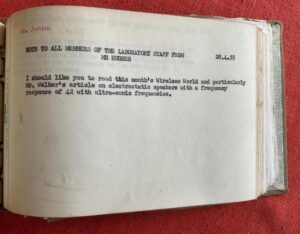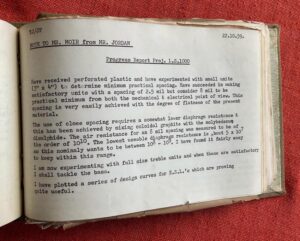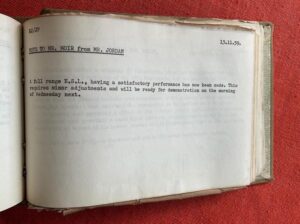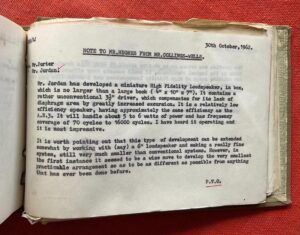In the April and May 2022 editions of Hi-Fi News, Steve Harris wrote about the early competitors to the famous QUAD electrostatic loudspeaker (ESL). In addition to Peter Walker at QUAD, research was also underway in the UK at H.J. Leak & Company, Pye & Company (who filed several patents) and Goodmans Industries.
The Goodmans development – known as Project LS1000 – was undertaken by Ted Jordan and conducted in extreme secrecy. Goodmans set up a specialised laboratory for the work and even had a sign made for the door: “No entry without the consent of E. J. Jordan”!
Ted kept a log of his development work but, frustratingly, not the final prototype, which was demonstrated at Goodmans on 18 November 1959. We can, however, glean some idea of the speed of progress from the memos passed within Goodmans at the time. We have Ted’s complete set of office memos, from his start at Goodmans in 1952 until 1963, when he left to set up Jordan-Watts, with Goodmans’ export sales manager, Lesley Watts.
The original article by Peter Walker, in Wireless World, set the cat among the loudspeaker pigeons when it was published in May 1955. Goodmans scrambled to attend the first demonstration of Walker’s baby later that month and immediately launched a patent search, to ensure there was freedom to develop their own ESL. Ted was assigned to the project and given free rein to pursue the development. He got as far as a working prototype, demonstrated at the Audio Fair in April, 1956 – just a few rooms away from the newly-launched QUAD ESL.
Not much is known of that first version, but one contemporary description gives it as 4’3” (130 cm) wide by 3’6” (107 cm) tall, power handling 15 watts and “the purity of the quality of reproduction is beyond dispute”.
Intriguingly, Ted was obviously aware at the very beginning that an ESL puts unique stresses on an amplifier. He submitted a Goodmans memo from September 1955 suggests developing a specialised amplifier and, in a very far-sighted move, taking advantage of newly-developed PCBs and transistor circuits.
Several prototypes of the new electrostatic loudspeaker were developed, each improved model being demonstrated at successive Audio Fairs.
A memo dated 13 November 1959, invites everyone to a demonstration of the final version the following Wednesday.
And then … nothing more appears in the documentation.
Ted produced a short report detailing the development of LS1000 and said that that the final prototype possessed the following advantages over any other system (ie the QUAD ESL):
1. It is considerably smaller
2. Efficiency is higher overall
3. Bass response extended and has greater relative output
4. The system can be placed against a wall
5. Considerably better polar response
“The project has now been shelved for an undefined period due to Company policy.”
Looking at other documents from this period, it’s clear that the new head of Goodmans was less interested in the hi-fi market and more dedicated to the OEM and PA markets, which he saw as more lucrative. Which is fair enough – by now Goodmans was a substantial company with over 600 employees. But it is extremely intriguing to wonder what this Goodmans ESL could have been like and how much further Ted could have taken it.
However, within a couple of years Ted was busy with a new, ground-breaking project which was, eventually, to become the Goodmans Maxim.
But that’s a story for another time …







